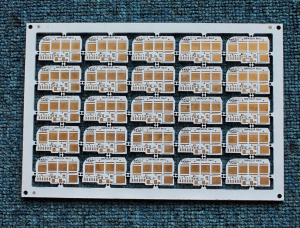
Products
Aluminum metal core pcb
Product Detail
| Layers | 2 layers |
| Board thickness | 1.6MM |
| Material | Aluminum base |
| Copper thickness | 1/1 OZ(35um) |
| Surface Finish | ENIG Au Thickness 0.8um; Ni Thickness 3um |
| Min Hole(mm) | 0.3mm |
| Min Line Width(mm) | 0.2mm |
| Min Line Space(mm) | 0.2mm |
| Solder Mask | Black |
| Legend Color | White |
| Mechanical processing | V-scoring, CNC Milling(routing) |
| Packing | Anti-static bag |
| E-test | Flying probe or Fixture |
| Acceptance standard | IPC-A-600H Class 2 |
| Application | Automotive electronics |
Metal Core PCB or MCPCB
Metal Core PCB (MCPCB) is known as Metal Backplane PCB or Thermal PCB. This type of PCB uses a metal material instead of the typical FR4 for its base, the heat sink portion of the board.
As is known heat is generated on the board for some reason Electronic components during operation. Metal transfers heat from the circuit board and redirects it to Metal core or metal heat sink backing and key savings Element.
In a multilayer PCB you will find a uniform number of layers distributed on the metal core side. For example, if you look at On a 12-layer PCB, you’ll find six layers on the top and six layers on the bottom, in the middle is the metal core.
MCPCB or Metal Core PCB Also known as ICPB or Insulated Metal PCB, IMS or Insulated Metal Substrates, Metal Clad PCBs and Thermal Clad PCBs.
For you For better understanding we will just use the term metal core PCB throughout this article.
The basic structure of a metal core PCB includes the following:
Copper Layer – 1oz.to 6oz. (most common is 1oz or 2oz)
circuit layer
Dielectric layer
Solder mask
Heat sink or heat sink (metal core layer)
Advantage for MCPCB
Thermal Conductivity
CEM3 or FR4 are not good at conducting heat. if hot
The substrates used in PCBs have poor conductivity and can damage the components of the PCB board. That’s when metal core PCBs come in handy.
MCPCB has excellent thermal conductivity to protect components from damage.
Heat dissipation
It provides excellent cooling capacity. Metal core PCBs can dissipate heat from an IC very efficiently. The thermally conductive layer then transfers the heat to the metal substrate.
Scale stability
It offers higher dimensional stability than other types of PCBs. After the temperature is changed from 30 degrees Celsius to 140-150 degrees Celsius, the dimensional change of the aluminum metal core is 2.5~3%.
Reduce distortion
Since metal core PCBs have good heat dissipation and thermal conductivity, they are less prone to deformation due to induced heat. Due to this characteristic of metal core, PCBs are the first choice for power supply applications that require high switching.










